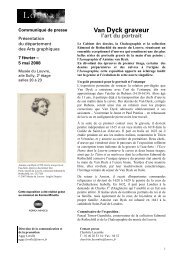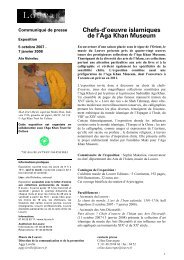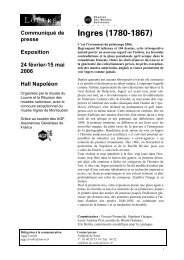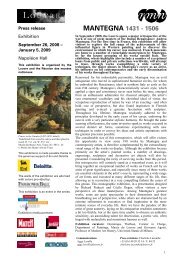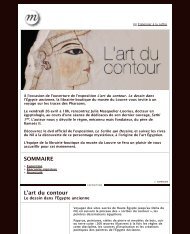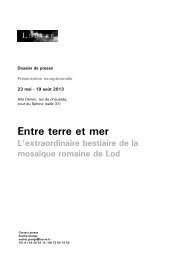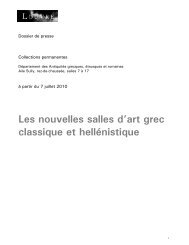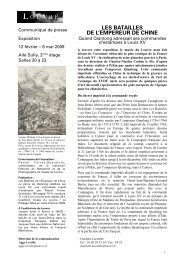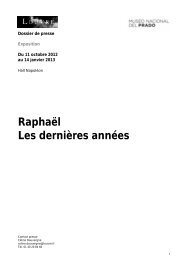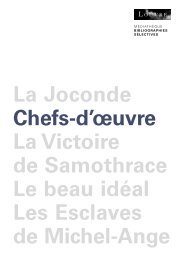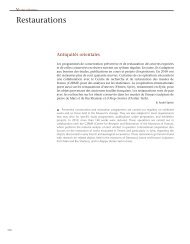Cercle International du Louvre - Musée du Louvre
Cercle International du Louvre - Musée du Louvre
Cercle International du Louvre - Musée du Louvre
Create successful ePaper yourself
Turn your PDF publications into a flip-book with our unique Google optimized e-Paper software.
Les expositions dans le monde<br />
de 2009 à 2011<br />
Exhibitions around the world<br />
between 2009 and 2011<br />
1 Arles<br />
De l’esclave à l’empereur<br />
From Slave to Emperor<br />
2 Troyes<br />
Sculptures champenoises<br />
Sculptures from the Champagne Region<br />
3 Périgueux<br />
Un monastère égyptien<br />
An Egyptian Monastery<br />
4 Montauban<br />
Ingres et les modernes<br />
Ingres and the Moderns<br />
5 Le Mans / Lyon / Sarrebourg<br />
Une autre Égypte. Collections coptes<br />
<strong>du</strong> <strong>Louvre</strong><br />
Another Egypt. Coptic Collections<br />
from the <strong>Louvre</strong><br />
6 Reims<br />
De Corot à l’art moderne<br />
From Corot to Modern Art<br />
7 Florence<br />
La Renaissance italienne dans<br />
la collection Edmond de Rothschild<br />
Italian Renaissance Art from<br />
the Collection of Edmond de Rothschild<br />
8 Vérone (Verona)<br />
De Corot à l’art moderne<br />
From Corot to Modern Art<br />
9 Athènes<br />
Le goût à la grecque<br />
A taste for Greek<br />
10 Tokyo / Osaka<br />
L’Enfance dans les collections<br />
<strong>du</strong> musée <strong>du</strong> <strong>Louvre</strong><br />
Childhood in the <strong>Louvre</strong>’s Collections<br />
11 Tokyo / Kyoto<br />
Peinture européenne <strong>du</strong> xvIIe siècle<br />
17th-century European Painting<br />
12 Tokyo<br />
Museum Lab – van Hoogstraten,<br />
Les Pantoufles, la place<br />
<strong>du</strong> spectateur réinventée<br />
Museum Lab – van Hoogstraten,<br />
The Slippers: Experimenting<br />
with One’s Gaze<br />
13 Tokyo<br />
Museum Lab – Portraits de femmes<br />
en Égypte, il y a 1 800 ans<br />
Museum Lab – Portraits of Women<br />
in Egypt, 1800 Years Ago<br />
14 Taïpeï / Kaohsiung / Pékin (Beijing) /<br />
Hangzhou / Wuhan / Cheng<strong>du</strong><br />
Exposition tactile<br />
« Le mouvement sculpté »<br />
Sculpted Movement –<br />
A Tactile Exhibition<br />
15 Québec<br />
Ingres et les modernes<br />
Ingres and the Moderns<br />
16 Atlanta / Minneapolis<br />
The <strong>Louvre</strong> and the Masterpiece<br />
17 Rio de Janeiro / Buenos Aires<br />
Trésors <strong>du</strong> <strong>Louvre</strong> :<br />
sculptures de Houdon<br />
Treasures from the <strong>Louvre</strong> –<br />
Houdon’s Sculptures<br />
18 La Havane (Havana) / Montevideo<br />
Images <strong>du</strong> <strong>Louvre</strong> :<br />
six siècles de peinture européenne<br />
Pictures from the <strong>Louvre</strong>:<br />
Six Centuries of European Painting<br />
19 Bogota / Medellin /<br />
Santo Domingo / Mexique (Mexico)<br />
Exposition tactile « D’après l’Antique »<br />
Tactile Exhibition « According to Antiquity »<br />
20 Colmar<br />
Le <strong>Louvre</strong> à Colmar. Collections coptes<br />
<strong>du</strong> <strong>Louvre</strong><br />
Coptic Collections from the <strong>Louvre</strong><br />
21 Madrid<br />
Antiquités d’Arabie<br />
Arabian Antiquities<br />
22 Valence (Valencia)<br />
Les Tanagras : visions rêvées<br />
d’une autre Grèce ?<br />
Tanagras: Dreamlike visions<br />
of Another Greece?<br />
23 Moscou (Moscow)<br />
Napoléon et le <strong>Louvre</strong><br />
Napoleon and the <strong>Louvre</strong><br />
24 Moscou (Moscow)<br />
Arts graphiques<br />
Graphic Arts<br />
25 Abou Dabi (Abu Dhabi)<br />
Chantier <strong>du</strong> <strong>Louvre</strong> Abou Dabi<br />
<strong>Louvre</strong> Abu Dhabi under construction<br />
19<br />
16<br />
18<br />
15<br />
17<br />
<strong>Cercle</strong> <strong>International</strong> <strong>du</strong> <strong>Louvre</strong><br />
<strong>International</strong> Council of the <strong>Louvre</strong><br />
21<br />
3<br />
22<br />
2<br />
6<br />
4 1<br />
5<br />
20<br />
8<br />
7<br />
9<br />
23<br />
24<br />
25<br />
14<br />
11<br />
10<br />
12<br />
13
Dès sa création en 1793, le <strong>Louvre</strong> a été conçu<br />
comme un musée universel. Dans un esprit<br />
d’ouverture hérité <strong>du</strong> Siècle des lumières<br />
et de la Révolution française, sa mission<br />
a toujours été de faire connaître au plus grand<br />
nombre possible de visiteurs les plus beaux<br />
témoignages <strong>du</strong> génie humain à travers<br />
les siècles. Les collections se déploient sur<br />
plusieurs millénaires et couvrent un territoire<br />
qui va de l’Amérique aux frontières de l’Inde<br />
et de la Chine. Elles font <strong>du</strong> <strong>Louvre</strong> un lieu<br />
de dialogue permanent entre les civilisations,<br />
un lieu de découverte et de ravissement pour<br />
les huit millions et demi de visiteurs annuels,<br />
venus des quatre coins <strong>du</strong> monde.<br />
Pour nourrir et renouveler cette vocation<br />
universelle, le <strong>Louvre</strong> s’attache à développer<br />
une action internationale soutenue et<br />
diversifiée. Elle se tra<strong>du</strong>it par l’organisation<br />
d’expositions sur tous les continents,<br />
mais aussi par le développement de chantiers<br />
de fouilles (Égypte, Soudan, Iran, Syrie),<br />
de coopérations scientifiques couplées à<br />
des actions de formation (Yémen, Azerbaïdjan,<br />
Oman, Arabie saoudite, Syrie…).<br />
Des partenariats innovants ont également<br />
vu le jour comme le projet <strong>du</strong> <strong>Louvre</strong> Atlanta<br />
aux États-Unis, le développement de DNP<br />
<strong>Louvre</strong> - Museum Lab au Japon (développement<br />
d’outils multimédia innovants) ou encore<br />
le projet <strong>Louvre</strong> Abou Dabi.<br />
Cette ouverture à l’international nous<br />
a con<strong>du</strong>its à créer le <strong>Cercle</strong> <strong>International</strong> <strong>du</strong><br />
<strong>Louvre</strong>. Son objectif est de réunir des amateurs<br />
d’art de tous horizons désireux de partager<br />
leur intérêt pour la culture et leur passion<br />
commune pour le <strong>Louvre</strong> et ce qu’il représente.<br />
Henri Loyrette<br />
Président-directeur, musée <strong>du</strong> <strong>Louvre</strong><br />
Christopher Forbes<br />
Président, <strong>Cercle</strong> <strong>International</strong> <strong>du</strong> <strong>Louvre</strong><br />
When it first opened to the public in 1793,<br />
the <strong>Louvre</strong> was conceived as a world museum<br />
open to all mankind – a vision that is as true today<br />
as it was then. Imbued with the spirit of openness<br />
inherited from the Enlightenment and the French<br />
Revolution, it has always sought to expose<br />
the largest possible number of visitors to the most<br />
outstanding examples of humanity’s creative genius<br />
down through the centuries. Its collections span<br />
millennia and cover the world from the Americas<br />
to the farthest reaches of India and China.<br />
They make the <strong>Louvre</strong> a permanent setting where<br />
civilizations meet, a place of discovery and<br />
wonderment for the eight and a half million visitors<br />
it welcomes each year from all parts of the world.<br />
In order to nurture and cultivate its vocation<br />
as a museum for all, the <strong>Louvre</strong> has sought<br />
to develop a sustained and diversified international<br />
outreach program by organizing exhibitions<br />
on every continent. It also con<strong>du</strong>cts archaeological<br />
expeditions (in Egypt, Sudan, Iran and Syria) and has<br />
been involved in scientific and e<strong>du</strong>cational projects<br />
(in Yemen, Azerbaijan, Oman, Saudi Arabia, Syria,<br />
and other countries). Creative partnerships have<br />
also been established, including the <strong>Louvre</strong> Atlanta<br />
project in the United States, the development<br />
of DNP <strong>Louvre</strong> - Museum Lab in Japan (for the<br />
development of new multimedia technologies)<br />
and the <strong>Louvre</strong> Abu Dhabi project.<br />
Our global exposure has convinced us<br />
of the need to create the <strong>International</strong> Council,<br />
to bring together art lovers from every corner<br />
of the world who wish to share their interest<br />
in culture and their common passion for the <strong>Louvre</strong><br />
and for what it represents.<br />
Henri Loyrette<br />
President-Director, <strong>Musée</strong> <strong>du</strong> <strong>Louvre</strong><br />
Christopher Forbes<br />
Chairman, <strong>International</strong> Council of the <strong>Louvre</strong><br />
Michel-Ange, Esclaves<br />
Slaves<br />
© 2006 musée <strong>du</strong> <strong>Louvre</strong> / Pierre Philibert 3
4<br />
Le musée <strong>du</strong> <strong>Louvre</strong><br />
The <strong>Louvre</strong> Museum<br />
Avant d’être un musée, le <strong>Louvre</strong> a d’abord été<br />
un château fort, puis un palais qui, depuis le<br />
XII e siècle, a étroitement accompagné l’histoire<br />
de France. Demeure des rois et des empereurs<br />
de France, dont François I er , Louis XIV – avant<br />
qu’il ne s’installe à Versailles –, Napoléon I er<br />
jusqu’à Napoléon III, il abrite de longue date<br />
les collections royales et impériales d’art,<br />
et son architecture n’a cessé de se transformer<br />
en captant le plus récent de la modernité.<br />
C’est en 1793, au cœur de la Révolution<br />
française, qu’il est devenu un musée universel,<br />
dédié à tous les arts, ouvert à tous les publics.<br />
C’est à travers le projet Grand <strong>Louvre</strong><br />
et l’édification en 1989 de la pyramide par<br />
l’architecte sino-américain Ieoh Ming Pei que<br />
le musée signe son entrée dans la modernité.<br />
En constante évolution, le <strong>Louvre</strong> compte<br />
parmi ses nombreux grands projets<br />
d’aménagement l’ouverture des nouvelles<br />
salles <strong>du</strong> département des Arts de l’Islam (2011)<br />
et la réouverture des salles des Objets d’art<br />
<strong>du</strong> XVIII e siècle (2012).<br />
Par sa fréquentation, le <strong>Louvre</strong> s’impose<br />
aujourd’hui comme le plus grand musée<br />
<strong>du</strong> monde.<br />
Before becoming a museum, the <strong>Louvre</strong> first<br />
served as a medieval fortress, then as a royal<br />
palace that has figured prominently in French<br />
history since the twelfth century. Home to France’s<br />
kings and emperors, from François I and Louis xIv<br />
– before he took up residence at versailles –<br />
to Napoleon Bonaparte and, finally, Napoleon III,<br />
it has long been a repository of royal and imperial<br />
art collections. Its design has kept evolving,<br />
a testament to changing architectural trends.<br />
In 1793, at the height of the French Revolution,<br />
it became a universal museum for all of the visual<br />
arts, open to everyone. In 1989, the <strong>Louvre</strong><br />
became a modern monument with the addition<br />
of the Pyramid, designed by the Chinese-American<br />
architect Ieoh Ming Pei.<br />
Continually changing, the <strong>Louvre</strong> has many<br />
major projects underway, including the opening<br />
of new rooms to house the Islamic Arts collections<br />
(2011) and the reopening of its displays of<br />
eighteenth-century French Decorative Arts (2012).<br />
Today, the <strong>Louvre</strong> welcomes more visitors<br />
each year than any other museum in the world.<br />
Escalier Mollien, décor<br />
Mollien staircase, ornementation<br />
© 2008 musée <strong>du</strong> <strong>Louvre</strong> / Christina vervitsioti 5
... et ses collections universelles<br />
... and its universal collections<br />
Les collections <strong>du</strong> <strong>Louvre</strong> comptent quelque<br />
35 000 œuvres d’art réparties sur 68 000 m²<br />
et couvrant une période qui s’étend<br />
de l’Antiquité au milieu <strong>du</strong> XIX e siècle.<br />
Les collections sont réparties en huit<br />
départements qui ont leur histoire propre,<br />
liée aux conservateurs, aux collectionneurs<br />
et aux donateurs.<br />
The <strong>Louvre</strong>’s collections house 35,000 works<br />
of art displayed in over 68,000 square meters<br />
of exhibition space. Its collections encompass<br />
Western art from the medieval period to 1848.<br />
The collections also hold formative works<br />
from the civilizations of the ancient world<br />
and works of Islamic art. The collections are<br />
grouped into eight Departments, each shaped<br />
and defined by the activities of its curators<br />
and donors.<br />
1. Frise des archers,<br />
palais de Darius Ier , Suse,<br />
vers 510 av. J.-C.<br />
Frieze with Archers,<br />
Palace of Darius 1st, Suse<br />
© 1996 musée <strong>du</strong> <strong>Louvre</strong> /<br />
Christian Larrieu<br />
2. Scribe accroupi,<br />
2600-2350 av. J.-C.<br />
The Seated Scribe<br />
© 1999 musée <strong>du</strong> <strong>Louvre</strong> /<br />
Georges Poncet<br />
3. Caryatide supportant<br />
la tribune de la salle des<br />
Caryatides, XVIe siècle<br />
Caryatid, room of the<br />
Caryatids<br />
© 1998 musée <strong>du</strong> <strong>Louvre</strong> /<br />
Étienne Revault<br />
4. Gregor Erhart<br />
Sainte Marie-Madeleine,<br />
vers 1515-1520<br />
St. Mary Magdalene<br />
© musée <strong>du</strong> <strong>Louvre</strong> /<br />
Pierre Philibert<br />
5. François-Désiré<br />
Froment-Meurice<br />
Coupe des vendanges,<br />
vers 1844<br />
Wine-Harvest Cup<br />
© 2004 musée <strong>du</strong> <strong>Louvre</strong> /<br />
Erich Lessing<br />
6. Raphaël<br />
La Vierge à l’enfant<br />
avec le petit saint<br />
Jean-Baptiste, dite<br />
La Belle Jardinière, 1508<br />
The Virgin and Child with<br />
the Young Saint John<br />
the Baptist, called La Belle<br />
Jardinière (The Beautiful<br />
Madonna of the Garden)<br />
© 2007 musée <strong>du</strong> <strong>Louvre</strong> /<br />
Angèle Dequier<br />
7. Leonard de Vinci<br />
Portrait d’Isabelle d’Este,<br />
1499-1500<br />
Portrait of Isabella D’Este<br />
© Erich Lessing<br />
8. Lion à queue articulée,<br />
XII e -XIII e siècle<br />
Lion with Articulated Tail<br />
© 2007 musée <strong>du</strong> <strong>Louvre</strong> /<br />
Claire Tabbagh / Digital<br />
Collections<br />
Le département<br />
des Antiquités orientales<br />
est consacré aux civilisations<br />
anciennes des pays<br />
<strong>du</strong> Proche et Moyen-<br />
Orient, sur une <strong>du</strong>rée qui<br />
s’étend depuis la naissance<br />
des villages apparus<br />
il y a plus de dix mille ans<br />
jusqu’à l’arrivée de l’Islam.<br />
The Department of Near<br />
Eastern Antiquities<br />
is devoted to the ancient<br />
civilizations of the Near<br />
East and encompasses<br />
a period that extends<br />
from the first settlements,<br />
which appeared more than<br />
ten thousand years ago,<br />
to the advent of Islam.<br />
1.<br />
Le département<br />
des Antiquités égyptiennes<br />
présente des vestiges<br />
des civilisations qui<br />
se sont succédé sur<br />
les bords <strong>du</strong> Nil, depuis<br />
la fin de la préhistoire<br />
(vers 4000 ans avant notre<br />
ère) jusqu’à l’époque<br />
chrétienne (à partir <strong>du</strong><br />
IV e siècle après J.-C).<br />
The Department of Egyptian<br />
Antiquities preserves<br />
artifacts from the civilizations<br />
that developed in the Nile<br />
valley from the late<br />
prehistoric era (c. 4000 BC)<br />
to the Christian period<br />
(4th century AD).<br />
2.<br />
Le département<br />
des Antiquités grecques,<br />
étrusques et romaines<br />
réunit des œuvres<br />
illustrant l’activité<br />
artistique d’une vaste<br />
région : Grèce, Italie<br />
et ensemble <strong>du</strong> Bassin<br />
méditerranéen, dont<br />
l’histoire s’étend de<br />
l’époque néolithique<br />
(IV e millénaire avant J.-C.)<br />
au VI e siècle de notre ère.<br />
The Department of Greek,<br />
Etruscan, and Roman<br />
Antiquities oversees works<br />
illustrating the art of a vast<br />
area that encompasses<br />
Greece, Italy, and the whole<br />
of the Mediterranean basin,<br />
spanning a period that<br />
stretches from Neolithic<br />
times (4th millennium BC)<br />
to the 6th century AD.<br />
3.<br />
Le département des<br />
Sculptures <strong>du</strong> Moyen Âge,<br />
de la Renaissance<br />
et des Temps modernes<br />
présente la plus importante<br />
collection au monde de<br />
sculptures françaises ainsi<br />
que des chefs-d’œuvre<br />
de la sculpture italienne<br />
et germanique.<br />
The Department of<br />
Medieval, Renaissance,<br />
and Modern Sculpture<br />
houses the most important<br />
collection in the world<br />
of French sculpture as well<br />
as masterpieces of Italian<br />
and German sculpture.<br />
4.<br />
Le département<br />
des Objets d’art expose<br />
un monde d’objets<br />
de formes, de matières<br />
et d’époques très variées ;<br />
des bijoux aux tapisseries,<br />
en passant par les ivoires,<br />
les bronzes, les céramiques<br />
et les meubles.<br />
On y découvre des œuvres<br />
allant <strong>du</strong> Moyen Âge<br />
à la première moitié<br />
<strong>du</strong> XIX e siècle.<br />
The Department<br />
of Decorative Arts presents<br />
a highly varied range<br />
of objects, including jewelry,<br />
tapestries, ivories, bronzes,<br />
ceramics, and furniture.<br />
The collection extends from<br />
the Middle Ages to the first<br />
half of the 19th century.<br />
5.<br />
Le département<br />
des Peintures répond<br />
à la dimension encyclopédique<br />
<strong>du</strong> musée avec<br />
des œuvres représentatives<br />
de toutes les écoles<br />
de peinture européennes,<br />
<strong>du</strong> XIII e siècle à 1848.<br />
The Department of Paintings<br />
reflects the encyclopedic<br />
scope of the <strong>Louvre</strong>,<br />
encompassing every<br />
European school from<br />
the 13th century to 1848.<br />
6.<br />
Le département des Arts<br />
graphiques réunit une<br />
exceptionnelle collection<br />
d’œuvres sur papier de<br />
toute technique (gravure,<br />
dessin, pastel, miniature...)<br />
et de chalcographies.<br />
Certaines œuvres,<br />
en raison de leur fragilité<br />
à la lumière, bénéficient de<br />
présentations temporaires ;<br />
une salle de consultation<br />
permet l’accès au public<br />
sur demande préalable.<br />
Ce département accueille<br />
notamment les œuvres<br />
admirables issues<br />
de la collection Edmond<br />
de Rothschild.<br />
The Department of Prints<br />
and Drawings is devoted<br />
to the museum’s extraordinary<br />
collection of works<br />
on paper, which includes<br />
prints, drawings, pastels,<br />
and miniatures. In addition<br />
to its collection of drawings,<br />
the department holds<br />
a collection of engraved<br />
plates and the Edmond<br />
de Rothschild bequest<br />
(prints, drawings and<br />
engravings). These fragile<br />
works are featured in<br />
temporary exhibitions and<br />
can also be viewed privately<br />
by appointment.<br />
7.<br />
Le département des Arts<br />
de l’Islam est aujourd’hui<br />
fermé pour préparer<br />
sa réouverture en 2011<br />
dans de nouveaux espaces<br />
situés dans la cour<br />
Visconti. Environ deux<br />
mille objets y seront<br />
exposés. Issues de mille<br />
trois cents ans d’histoire<br />
et de trois continents,<br />
ces œuvres témoignent<br />
de la diversité d’inspiration<br />
et de la créativité<br />
des terres d’Islam.<br />
The Department of Islamic<br />
Art is currently closed,<br />
but sche<strong>du</strong>led to reopen<br />
in 2011 in a new gallery<br />
in the visconti court.<br />
Some two thousand objects<br />
will be on display, reflecting<br />
the breadth of inspiration<br />
and creativity of the Islamic<br />
lands over thirteen centuries<br />
and three continents.<br />
6 7<br />
8.
Devenez membre <strong>du</strong> <strong>Cercle</strong> <strong>International</strong><br />
Become a member of the <strong>International</strong> Council<br />
Lancé en 2008 à l’occasion de la première<br />
exposition <strong>du</strong> <strong>Louvre</strong> à la Cité interdite (Pékin),<br />
le <strong>Cercle</strong> <strong>International</strong> soutient d’ambitieux<br />
projets internationaux portés par le musée :<br />
fouilles archéologiques, partenariats scientifiques,<br />
programmes de formation, pro<strong>du</strong>ctions<br />
multimédia. Il rassemble des personnes<br />
qui souhaitent contribuer au rayonnement<br />
<strong>du</strong> <strong>Louvre</strong> et participer à des événements<br />
uniques dans des lieux prestigieux.<br />
L’adhésion annuelle (valable pour deux<br />
personnes) est de 20 000 E (ou $25 000<br />
si vous faites votre don auprès des American<br />
Friends of the <strong>Louvre</strong>).<br />
Pour bénéficier des avantages fiscaux,<br />
trois options sont possibles :<br />
– vous faites un don directement au musée<br />
<strong>du</strong> <strong>Louvre</strong> si vous êtes imposé en France ;<br />
– vous faites un don via les American Friends<br />
of the <strong>Louvre</strong>, structure 501 (c)(3) basée<br />
à New York, si vous êtes imposé aux États-Unis ;<br />
– vous faites un don via le Transnational Giving<br />
Europe, réseau de grandes fondations<br />
européennes (Belgique, Irlande, Royaume-Uni,<br />
France, Pays-Bas, Allemagne, Suisse et Pologne)<br />
qui permet aux donateurs de bénéficier des<br />
dé<strong>du</strong>ctions fiscales mises en place dans le pays<br />
où ils sont résidents fiscaux.<br />
The <strong>International</strong> Council was launched in 2008,<br />
to coincide with the <strong>Louvre</strong>’s first exhibition<br />
at Beijing’s Forbidden City. Its objective is to<br />
generate support for the museum’s large-scale<br />
international projects, such as archaeological<br />
expeditions, scientific partnerships, e<strong>du</strong>cational<br />
programs and multimedia initiatives. The Council<br />
brings together indivi<strong>du</strong>als who wish to contribute<br />
to the <strong>Louvre</strong>’s worldwide activities, providing<br />
them with an opportunity to participate in exclusive<br />
events at international destinations.<br />
<strong>International</strong> Council members contribute<br />
annual membership <strong>du</strong>es (valid for two persons)<br />
of 20,000 euros (or 25,000 dollars if making their<br />
gift to American Friends of the <strong>Louvre</strong>).<br />
Council members wishing to receive tax<br />
de<strong>du</strong>ctions may choose between three options<br />
when making contributions:<br />
– if they are tax residents of France, they may pay<br />
their membership fee directly to the <strong>Louvre</strong>,<br />
– if they are subject to income tax in the United<br />
States, they may contribute to American Friends<br />
of the <strong>Louvre</strong>, a New York-based 501(c)(3)<br />
tax-exempt organization,<br />
– lastly, they may channel their contribution through<br />
Transnational Giving Europe, a network<br />
of foundations in the principal European countries<br />
(Belgium, Ireland, United Kingdom, France,<br />
The Netherlands, Germany, Switzerland and<br />
Poland), in order to qualify for tax de<strong>du</strong>ctions<br />
in their country of residence.<br />
8<br />
Soirée de gala « Liaisons au <strong>Louvre</strong> », juin 2008<br />
Gala dinner Liaisons au <strong>Louvre</strong>, June 2008<br />
© 2008 Stéphane Olivier / Artephoto<br />
9
10<br />
Les privilèges pour deux personnes<br />
Privileges for two people<br />
Un voyage annuel exceptionnel est organisé<br />
exclusivement pour les membres <strong>du</strong> <strong>Cercle</strong><br />
autour d’un des grands projets internationaux<br />
<strong>du</strong> musée. Des visites leur permettent de<br />
découvrir d’importantes collections d’art<br />
publiques et privées et d’explorer la scène<br />
artistique contemporaine. Des événements<br />
de prestige sont également organisés par<br />
des représentants de l’élite économique,<br />
diplomatique et culturelle <strong>du</strong> pays d’accueil.<br />
Les membres <strong>du</strong> <strong>Cercle</strong> <strong>International</strong><br />
sont invités à se joindre aux membres<br />
<strong>du</strong> Chairman’s Council lors des événements<br />
organisés par les American Friends of the<br />
<strong>Louvre</strong>. Ils sont en particulier invités à participer<br />
à leur voyage annuel autour de l’actualité <strong>du</strong><br />
musée <strong>du</strong> <strong>Louvre</strong> (exposition, nouvelle salle,<br />
art contemporain…) et à leurs soirées de gala.<br />
Les membres <strong>du</strong> <strong>Cercle</strong> sont également<br />
invités aux événements organisés par le <strong>Louvre</strong><br />
dans tous les pays où il a tissé des partenariats,<br />
notamment pour des expositions temporaires.<br />
À Paris, les membres <strong>du</strong> <strong>Cercle</strong> <strong>International</strong><br />
bénéficient d’un accueil personnalisé et d’un<br />
accès privilégié aux collections en relation<br />
étroite avec les conservateurs <strong>du</strong> musée <strong>du</strong><br />
<strong>Louvre</strong>. Ils sont conviés à des visites privées<br />
en avant-première des expositions ainsi<br />
qu’aux événements réservés aux mécènes.<br />
Un abonnement à la revue Grande Galerie :<br />
Le Journal <strong>du</strong> <strong>Louvre</strong> est offert à chaque<br />
membre pendant la <strong>du</strong>rée de son adhésion.<br />
Des remerciements et la mention des<br />
membres <strong>du</strong> <strong>Cercle</strong> <strong>International</strong> figureront<br />
dans la lettre d’information <strong>du</strong> <strong>Cercle</strong><br />
<strong>International</strong>, dans celle des American Friends<br />
of the <strong>Louvre</strong> et dans le rapport d’activité<br />
<strong>du</strong> musée <strong>du</strong> <strong>Louvre</strong>.<br />
In return for their generosity, members receive<br />
a number of benefits including an annual trip<br />
focused on one of the <strong>Musée</strong> <strong>du</strong> <strong>Louvre</strong>’s<br />
international projects. Members visit leading public<br />
and private art collections, explore the<br />
contemporary art scene and enjoy events hosted<br />
by prominent representatives of the business,<br />
diplomatic and cultural communities in the<br />
countries they visit.<br />
<strong>International</strong> Council members are also<br />
invited to join members of the Chairman’s Circle<br />
of American Friends of the <strong>Louvre</strong> on their annual<br />
trips to France and in the U.S. and at gala fund<br />
raising events.<br />
Council members are also guests at events<br />
organized by the <strong>Louvre</strong> in the countries where<br />
the museum works in partnership with others,<br />
including openings of temporary exhibitions.<br />
In Paris, <strong>International</strong> Council members enjoy<br />
personalized, exclusive access to the collections<br />
and to the museum’s curators and staff. They<br />
receive invitations to pre-opening private showings<br />
and to special events for museum patrons.<br />
Members also receive the <strong>Louvre</strong> magazine<br />
Grande Galerie for the entire <strong>du</strong>ration of their<br />
membership.<br />
<strong>International</strong> Council members will be<br />
recognized by name in the Council’s newsletter<br />
and that of American Friends of the <strong>Louvre</strong>,<br />
as well as in the <strong>Louvre</strong> Museum’s annual report.<br />
Soirée « 20 ans de la pyramide », mai 2009<br />
Gala dinner for the 20th anniversary<br />
of the Pyramid, May 2009<br />
© 2009 Stéphane Olivier, Artephoto<br />
Contacts<br />
<strong>Musée</strong> <strong>du</strong> <strong>Louvre</strong><br />
Direction <strong>du</strong> développement<br />
et <strong>du</strong> mécénat<br />
75058 Paris Cedex 01<br />
France<br />
Ina Giscard d’Estaing<br />
Major Gifts<br />
<strong>International</strong> Council<br />
Tél. : + 33 1 40 20 54 57<br />
Fax : +33 1 40 20 68 99<br />
ina.giscarddestaing@louvre.fr<br />
www.louvre.fr<br />
American Friends<br />
of the <strong>Louvre</strong><br />
60 Fifth Avenue<br />
New York, NY 10011<br />
USA<br />
Sue Devine<br />
Executive Director<br />
Tél. : 212 367-2649<br />
Fax : 212 206-5106<br />
sdevine@aflouvre.org<br />
www.aflouvre.org



